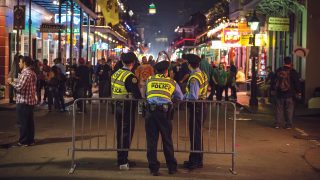

In police work, the flashlight is an essential device. But depending on its use, it can be an asset or a liability. Law Enforcement Officers Killed and Assaulted (LEOKA) studies conducted by the FBI over the last 10 years have shown that low-light conditions attributed to approximately 70% of officer fatalities. Regardless of which study you believe, the majority of officer-involved shootings occur in low-light or no-light conditions. These conditions also contributed to the majority of mistake-of-fact shootings where officers believed that the persons they engaged were armed, when in fact they were not. Some high-profile cases — like the Diallo shooting in New York, where four officers shot an unarmed man producing his wallet under poorly lit conditions at night — are testaments to the difficulties officers face when confronting individuals, especially those they believe to be dangerous, in low-light conditions.
For many law enforcement agencies, low-light training has consisted of going to the range and learning how to fire their weapons in conjunction with their flashlights. The firearms instructor shows them a variety of ways to manipulate their flashlight and weapon using different handheld techniques. Perhaps a few other variables were introduced, but for the most part, the training was solely conducted at the range during some type of firing sequence. Over the years, very little has changed in regards to low-light training.
Flashlights, however, have come a long way over the last 20 years. Some dinosaurs who may still be on the job can recall carrying something that resembled more of a baseball bat than a flashlight, with the only instruction on its use being to use it as an impact weapon if it became necessary. Today’s flashlights in law enforcement are compact, powerful and tactically advantageous.
Many officers purchase or are issued a flashlight with very little knowledge or training on its use. A particular model may have been recommended by a fellow officer, or it is a piece of equipment that has been issued and past on over the years. The officer carries their flashlight as an essential tool to aid them in their duties. Whether they are aware of it, they will be using their flashlights in many situations and depending on how and when they use them, they can either aid them or make them and those around them a target.

Selecting a flashlight
The type of flashlight that officers carry can also be a concern. Without going into too much detail, you should be able to maintain your light in your hand while clearing any type of stoppage with your weapon. Placing the light on the ground, tucking it under your arm or between your legs just wastes valuable time in a critical moment. It makes things much worse if the light is stuck in the “on” position while trying to clear the stoppage by telegraphing to your adversary that your weapon is out of commission. Practice stoppages with your weapons and clearing them with a light in hand and honestly evaluate your equipment. Things such as size, power source, lumens (brightness), tactically correct switching and incandescent versus LED lights are all important considerations when selecting a truly tactical light.
Along with the product upgrades have come advances in training and tactics. Officers today are learning that their flashlights are useful in many situations, not just in rare circumstances when using their light in conjunction with their firearm to deliver deadly force as they experienced during training on the range. Some of the basic applications for using our flashlights are: searching, navigating, communicating, threat identification and controlling.
Searching
When conducting a search, whether indoors or outdoors, officers are encouraged to keep the light out and away from their center line, which is in contrast to exactly where it would be if you were using some of the range training exercises discussed previously. Lights that are mounted to handguns are also a problem for essentially the same reason; while searching — not knowing where the suspect(s) are located — we are telegraphing not only our position, but directing the suspect to fire on us at center mass. By keeping the light out and away from the body, using the light in a strobe effect, at random intervals, we not only present a harder target to hit, but we also confuse our foe as to our exact location.
Navigating
While navigating, officers use the light to “paint a path” to their next destination. The officer uses the light to determine their route and to ensure their next location is not already occupied, they then go dark and move to it. Officers continue this maneuver throughout the search, or to get to a position of advantage. This tactic conceals the officers advance and confuses their exact location to any would-be suspect.
Communication
While working in low-light or no-light conditions it is sometimes difficult, if not impossible, to accurately direct other officers to specific areas. While searching a structure, one cannot simply point and say, “The suspect is behind that door.” Other officers may not see which door is being referred to. Instead use the beam of the flashlight to illuminate the door and clarify exactly which door the suspect is behind. The light of beam from the flashlight becomes a tool to signal and direct others when visibility is low.
Threat identification
As law enforcement officers, it is not only our duty, but our obligation to make every effort possible to identify threats swiftly and correctly. With the aid of a flashlight, officers are able to distinguish physical descriptions of suspects, whether it be physical attributes or clothing. As previously stated, low-light conditions attribute more to mistake-of-fact shootings than any other single variable. This is due to a number of factors, one of which is our inability to distinguish whether the suspect possesses a weapon. This is why flashlights are indispensable in our industry.
Control
This application is probably one of the most beneficial because it acts as a force multiplier. Once the suspect has been located, all available light should be directed at the suspect’s eyes. The effect on the suspect is immediate and somewhat incapacitating. From the suspect’s viewpoint, the only thing they can see is an intense bright light surrounded by a dark abyss. With the light remaining locked on the suspect’s eyes, they are now vulnerable to a multitude of tactical options. Practice this application from both the officer’s and the suspect’s viewpoint during training in order to gain a true appreciation of its effectiveness.
As with so many other things, one tactic does not work for every situation, we have to be able to change and adapt to the circumstances we find ourselves in. The way officers do things in well-lit conditions may vary from the way they do them in low-light or no-light conditions.
For example, when dealing with a suspect on a felony stop in low-light, instead of having the suspect face away, have them face forward looking directly into a wall of light. When backing up other officers on traffic stops at night, turn off all of your lights except the rear wig-wags so as not to backlight your fellow officers.
When clearing structures, instead of turning the lights on when entering a room, turn them off to control backlighting and manipulate the environment at your discretion by activating your flashlight when applicable. These are just a few examples of many different applications.
Be conscious of backlighting, by eliminating or minimizing being exposed to light from the rear, which will cause yourself or others to be silhouetted. Another issue that arises is backsplash. This occurs when the beam of light strikes a barrier, such as a wall or floor, and bounces back causing the entire area to light up, thus exposing anyone in the immediate vicinity.
This is not a perfect world and there are no guarantees for success. Whether to use light or to operate under the cloak of darkness takes practice, discipline and understanding. To see without being seen is the greatest advantage in any tactical environment. Law enforcement is an unpredictable and unforgiving profession. In order to prevail, officers must train in the conditions similar to those encountered on the streets and utilize the tools and the tactics provided to be afforded the best chances to overcome their adversaries.

As seen in the January 2021 issue of American Police Beat magazine.
Don’t miss out on another issue today! Click below:





